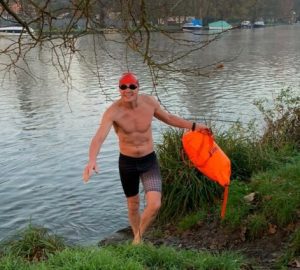Pilates for swimming: Increase efficiency, reduce drag and increase speed
Physiotherapist Darren Wigg explains how to use Swimming Specific Pilates (SSP) to swim more efficiently and reduce injury
As an ex-international swimmer and current sports physiotherapist of 15 years, I have spent thousands of hours trying to understand how and why swimmers become injured. It’s a little different to most sports as there is no contact and no ground reaction force to deal with so we rarely see traumatic injuries. Swimmers injuries tend to creep up on them gradually. It is my belief that the most common primary cause of swimming injury is also the most common cause of impaired performance and that cause is inefficiency of stroke.
Essentially, every time we apply force to the water as a swimmer, it should be with the sole purpose of moving us forward in a straight line and never sideways! If we apply our force in the wrong direction, inevitably, we compensate for that, to maintain our forward movement. Every compensation increases our drag, wastes our energy and slows us down. It also increases our injury risk by creating unnecessary overload.
Swimming requires the body to be strong, powerful, flexible, controlled and coordinated, all while our muscles and other soft tissues are in lengthened positions (such as streamline or during our initial catch position). In addition, this is all while being supported by the buoyancy of the water and working against the force of gravity. Unique! A unique environment requires unique training.
Darren Wigg is the Director and Clinical Lead at Newcastle Physiotherapy. He was a GB Senior International Swimmer 1996-2001 and Lead Physiotherapist, Open Water Swimming, Team GB, London 2012. He delivers 1-2-1 and group SSP Zoom classes to over 50 swimmers each week. If you are interested or would like to find out more, please get in touch!
How does SSP enhance swimming performance?
1 – Develops aquatic postural awareness and understanding of swimming technique
2 – Develops muscle activation and functional strength of the swimming muscles
3 – Develops functional flexibility of the swimming muscles
4 – Develops swimming specific coordination
5 – Assists in minimising swimming specific compensatory movements
SSP is based on precise movement control in swimming specific postures. Movement control of the four quadrants of the body and trunk, with the aim of abolishing any compensatory movements that arise from deficits in postural muscle strength and flexibility. It is a perfect fit for swimmers and a part of the puzzle that many swimmers may be missing from their programmes and a part that will be even more helpful in our current climate when it is more difficult to access training facilities.
Quality and control
As you can see from the exercises, demonstrated by Keri-anne Payne, they are performed focussing on movement quality and control. They are focussed on stabilising one part of the body while activating and mobilising another. In order to swim in a straight line and minimise drag, we need our bodies to execute these skills perfectly and precisely. We need to eradicate any unwanted lateral movements if we want to travel in a straight line, efficiently. The muscle groups we focus on in the videos are particularly important in swimming. Our arm movement is initiated from our scapular muscles (rotator cuff and lower trapezius), we need them to be strong and fatigue resistant in order to be efficient and reduce the risk of shoulder and neck injury. Our leg kick is initiated by the deep abdominals, glutes and hip flexors. We need them to be strong and fatigue resistant to power our kick efficiently and reduce our risk of lower back injury. Our trunk and hip rotation need to occur in perfect synchronicity to maintain our rhythm and coordination. Throughout these movements, we pay strong attention to the position of our hands and feet; their position is extremely important in generating effective propulsion through the water.
Swimmers need to train these muscle groups and movement patterns in a swimming-specific way, in order to gain some carry-over into the stroke. By performing exercises in this way, we can also gain a valuable insight into swimmers’ technique and movement patterns in a way that is difficult to establish when in the water. Why not spend some time on your aquatic postural awareness and movement control rather than your next swim session? Remember, increase efficiency, reduce drag, increase speed!
Swimming Specific Pilates exercises
Try these SSP exercises at home – as demonstrated by Keri-anne Payne, double open water world champion, triple Olympian and Olympic silver medallist
Exercise 1
Exercise 2
Exercise 3







